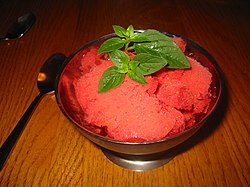This is an old revision of this page, as edited by Yaksmarrow (talk | contribs) at 20:24, 10 November 2022. The present address (URL) is a permanent link to this revision, which may differ significantly from the current revision.
Revision as of 20:24, 10 November 2022 by Yaksmarrow (talk | contribs)(diff) ← Previous revision | Latest revision (diff) | Newer revision → (diff) Frozen dessert Not to be confused with Sorbetes, Sherbet (frozen dessert), Sherbet (powder), or Sharbat. For the Hannibal episode, see Sorbet (Hannibal). Raspberry sorbet Raspberry sorbet | |
| Course | Dessert |
|---|---|
| Serving temperature | Frozen |
| Main ingredients | Water, sugar, flavoring (fruit juice or purée, wine, or liqueur, and very rarely honey) |

Sorbet (/sɔːrˈbeɪ/), also called "water ice", is a frozen dessert made using ice combined with fruit juice, fruit purée, wine, liqueur, honey and etc. Generally sorbets do not contain dairy ingredients, while the sherbets do.
Etymology
The word "sorbet" enters the English language from French, derived from the Italian sorbetto, which in turn came from the Ottoman Turkish or Iranian sharbat, originally referring to a type of beverage. (The word sharbat is derived from the Arabic verb "shariba", which means "to drink"). The first Western mention of sherbet is an Italian reference to something that Turks drink. The word sherbet entered the Italian language as sorbetto, which later became sorbet in French.
Sherbet in Europe still refers to a type of flavored drink, while North American sherbet is similar to sorbet. August Escoffier describes sorbet as "very light and barely-congealed ices, served after the Entrées. They serve in freshening the stomach; preparing it to properly receive the roast. They are appetizers and help to aid digestion."
Oxford English Dictionary defines sorbet as an alternate term sharing the same meaning as sherbet, a beverage. The usage of "sorbet" to describe a beverage is attested to in the English language literature in the 16ths and 17th centuries. A 17th century text describes sorbetta as "a kinde of drinke made of Water, Suger, and iuyce of Lemonds, mixed with Amber and Muske." The term is still being used for drinks in the 19th century: "They resorted to drink coffee and sorbet, with laughter and merriment".
History
There are a number of legendary origin myths, unsupported by any known evidence, that attribute the origins of sorbet to historical figures like the Roman Emperor Nero, Marco Polo and the Italian duchess Catherine de' Medici.
The first recipe in French for flavoured ices appears in 1674, in Nicholas Lemery's Recueil de curiositéz rares et nouvelles de plus admirables effets de la nature. Recipes for sorbetti saw publication in the 1694 edition of Antonio Latini's Lo Scalco alla Moderna (The Modern Steward). Recipes for flavoured ices begin to appear in François Massialot's Nouvelle Instruction pour les Confitures, les Liqueurs, et les Fruits, starting with the 1692 edition. Massialot's recipes result in a coarse, pebbly texture. Latini claims that the results of his recipes should have the fine consistency of sugar and snow. When Europeans figured out how to freeze sherbet they began making sorbetto by adding fruit juices and flavorings to a frozen simple syrup base. In the US sherbet generally meant an ice milk, but recipes from early soda fountain manuals include ingredients like gelatin, beaten egg whites, cream, or milk.
Preparation
Like granitas and other ices, sorbet can be made without an ice cream maker. Alcohol, honey or corn syrup can be added to lower the freezing point and make softer sorbets.
Sorbet is usually made with fresh fruit and simple syrup, but other types of preparations exist. Tart sorbets are served as palate cleansers between savory courses of a meal. Mulled wine sorbet can be made with red wine, orange, lemons, mulling spices, ruby port, and egg whites. Muscat sorbet is made with dessert wine, lemon juice, and egg whites.
Givré (French for "frosted") is the term for a sorbet served in a frozen coconut shell or fruit peel, such as a lemon peel. Agraz is a type of sorbet with an acidic flavor attributed by Larousse Gastronomique to the Maghreb region of North Africa. It is made from almonds, verjuice, and sugar.
References
- ^ Davidson, Alan. The Oxford Companion to Food.
- Oxford English Dictionary
- Cousineau, Phil (2012-09-11). The Painted Word: A Treasure Chest of Remarkable Words and Their Origins. Simon and Schuster. ISBN 9781936740253.
By the time it left the deserts of Persia for the cities of Europe it had been transformed into an "Orientalized" dessert called sorbetto in Italian and sorbet in French.
- August Escoffier, The Escoffier Cook Book, 1976, ISBN 0517506629, translation of Le Guide Culinaire, 1903, p. 853
- Goldstein, Darra, ed. (2015). The Oxford Companion to Sugar and Sweets.
- Toussaint-Samat, Maguelonne (2009). A History of Food. Wiley. p. 675.
- ^ Weir, Caroline; Weir, Robin (2010). Ice Creams, Sorbets & Gelati:The Definitive Guide. Grub Street Cookery. p. 9. ISBN 978-1909808935.
- ^ Powell, Marilyn (2005). Cool: The Story of Ice Cream. Toronto: Penguin Canada. ISBN 978-0-14-305258-6. OCLC 59136553.
- Pappas, Lou Seibert (April 1997). Sorbets and Ice Creams: And Other Frozen Confections. Chronicle Books. pp. 11–15. ISBN 978-0-8118-1573-4.
- Liddell, Caroline; Weir, Robin (1996-07-15). Frozen Desserts: The Definitive Guide to Making Ice Creams, Ices, Sorbets, Gelati, and Other Frozen Delights. Macmillan. ISBN 978-0-312-14343-5.
- "What does givré mean?". www.definitions.net. Retrieved 2022-03-11.
- The New Larousse Gastronomique.
Bibliography
- Lang, Jenifer Harvey, ed. (1988). "Agraz". Larousse Gastronomique: The New American Edition of the World's Greatest Culinary Encyclopedia. New York: Crown Publishers. ISBN 0517570327. OCLC 777810992.